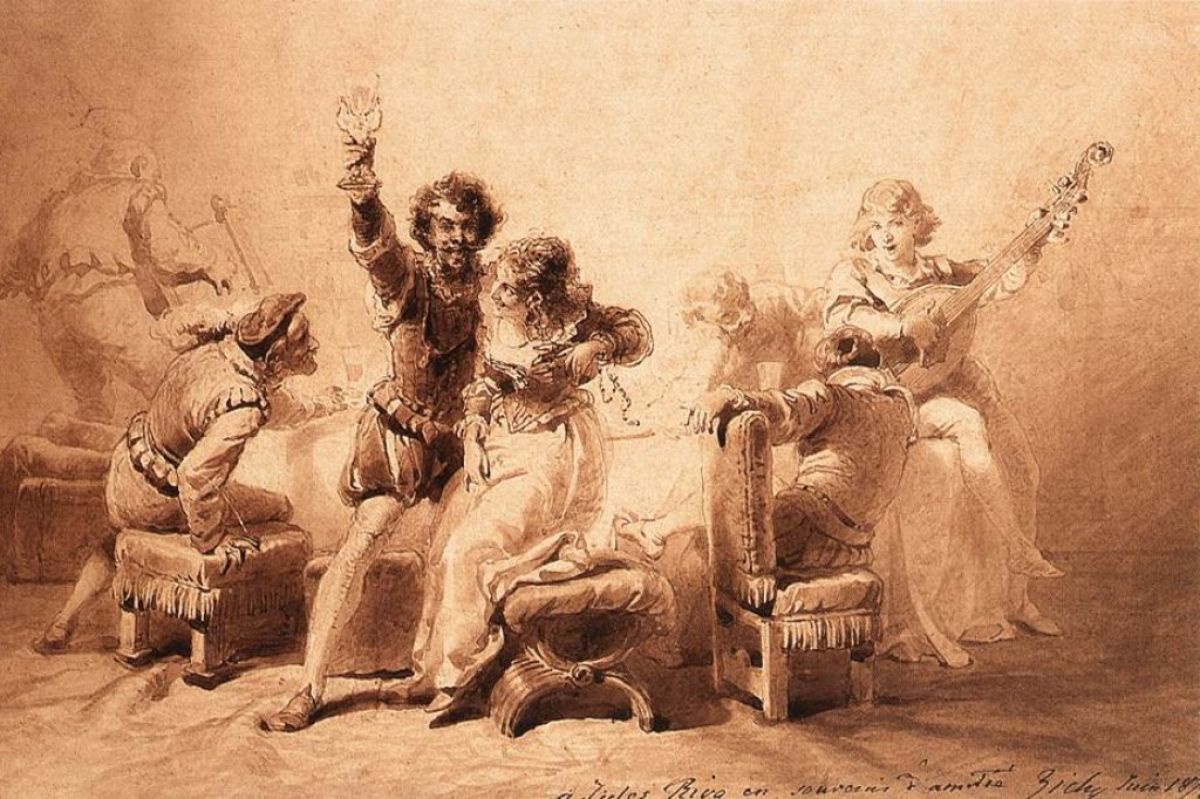Welcome to Harmonia . . . I’m Angela Mariani. What do the national drink of Hungary and a composition that is found only in one source have in common? Why, both are called Unicum! On Harmonia this week, we’ll look at an unicum composed in honor of the King of Hungary, listen to virtuosic, sumptuous polyphony of the fifteenth century by relatively unknown composers, and maybe even learn a bit about what makes them compositional tours de force! Plus, our featured release is Telemann’s Garden, the 2019 Pentatone debut of an ensemble with the memorable name of the Elephant House Quartet.
[Theme music fades]
MUSIC TRACK
Quadrivium, Vol 1
Cantica Symphonia; Giuseppe Maletto, direction.
Glossa,2005 / B000B0WOGW
Dufay:
Track 5: Gaude virgo, mater Christi, cantilena motet for 4 voices (4:39)
Cantica Symphonia, directed by Giuseppe Maletto, performed Guillaume Dufay’s cantilena motet “Gaude virgo, mater Christi” on their 2005 Glossa CD called Quadrivium, Vol 1. The Quadrivium, of course, comprises music, arithmetic, astronomy, and geometry, and this CD is possibly unique in being packaged with its own 10-page essay by an Italian professor of mathematics.
[Music bed under following text: La contenance angloise, Chant 1450, Nicolas Savoy, Christophorus, 2010 / B0045MRFQ6, Galfridus de Anglia, Guillaume Dufay, Tr 5: Che faro io - Missa Sancti Antonii Viennensis; Kyrie [excerpt of 04.03]
Unicum is a legendary herb liqueur - the national drink of Hungary. But in the jargon of musicology, an unicum (or, in English, sometimes “a unicum”) is a composition that is found in only one source. In this installment of Harmonia, we’ll be looking at one of the latter, though you are most welcome to sip a thimble full of the former while you listen. The composition in question is a motet celebrating the life of King Albert the Magnanimous, who was, among many other things, the King of Hungary, and who died in 1439. The second part of the motet names the singers in his choir – Brassart, Erasmo, Adam, Io de Sarto, Johannes, Tirion, Martin and Galer. Many of our listeners will have not heard of a single one of these people – very few 15th-century composers make it to the top of the charts, and how on earth can we know who “Adam” was? But the music they sang and composed is much more compelling than you might think. And, after all, what’s in a name?
Let’s begin with the singer in the choir about whom we know the most – the south Netherlandish composer and singer Johannes Brassart. We’re not sure when he was born - though it was likely between 1400 and 1405 - nor when he died - all we know is that it was before Oct 22, 1455. He was strongly associated with Liège throughout his career, principally with the church of St. John the Evangelist and the cathedral of St. Lambert (which was destroyed in the French Revolution).
But Brassart did not spend his entire life in Flanders. For example, he spent a short time in Rome as a singer in the Papal Chapel as a colleague of Guillaume Dufay when Martin V was Pope. It is therefore probably not coincidental that he would compose a motet honoring St. Martin. Let’s begin our journey here. Toward the end of the piece you’ll hear all the voices come together at the words “O Martine:”
MUSIC TRACK
Popes and antipopes
Orlando Consort
Metronome 1994 /B000002K3U
Brassart:
Tr. 13: Te dignitas presularis (4:00)
The Orlando Consort sang Te dignitas presularis by Johannes Brassart, on their 1994 Metronome recording Popes and Antipopes.
[Music bed under following text: La contenance angloise, Chant 1450, Nicolas Savoy, Christophorus, 2010 / B0045MRFQ6, Galfridus de Anglia, Guillaume Dufay, Tr 5: Che faro io - Missa Sancti Antonii Viennensis; Kyrie [excerpt of 04.03]
Some 30 compositions of Brassart survive, all sacred, many liturgical and all but one in Latin. His settings of the Ordinary, or the parts of the Mass that have the same words every time Mass is celebrated, are fairly typical of their time. The Propers, written for specific liturgical occasions, are less so, and Brassart’s Introits, sung as the priest approaches the altar for the celebration of the Eucharist, are among the earliest extant polyphonic settings of that part of the Mass. Alas, most of Brassart’s liturgical works have yet to make the leap off the page into the ethereal world of wavs and mp3’s.
Brassart’s motets, on the other hand, are better known. They are often datable either because of the manuscripts in which they appear are datable or because they mention specific people, places or events. For example, O rex Fridrice must have been composed for either the accession (1440) or the coronation (1442) of Friedrich III as Holy Roman Emperor. Let’s hear the ensemble Stimmwerk perform O rex Fridrice. It begins in two voices invoking Frederick as the friend of peace, then bursts into four polyphonic voices for the rest of the piece, (though during the Amen you might hear up to 6 voices). If you listen really carefully, you may be able to hear that the bottom voice repeats the same melody and rhythm 4 times, each time proportionately quicker than the previous one as the whole piece gains momentum and excitement. It is this that defines the motet as an isorhythmic motet:
MUSIC TRACK
Flos virginum
Stimmwerk
SACD 2015 / B010U6BOJ4
Johannes Brassart:
Tr 1: O Rex Fridrice - In Tuo Adventu (5:51)
We heard Stimmwerk singing Johannes Brassart’s O rex Fridrice on their 2015 SACD CD called Flos virginum (Motets of the 15th Century). Don’t worry if you did not hear the isorhythmic bottom part of the piece – you certainly would not be alone, either now or even in the C15, and in fact maybe you’re not even supposed to!
Want to try again? Here’s another 4-part motet of Brassart, also isorhythmic, but in a different way. This time, there is a rhythmic pattern in the lowest of the four parts that repeats five times at the same speed in the 2:20 of the piece, but there is no repeating melody. All the words of the prayer to the Virgin, “Hail Mary full of grace,” are heard, though they are interspersed with a lot of other words praising Mary:
MUSIC TRACK
Guide des insruments anciens
Simen Van Mechelen, Wim Becu, sacqueboutes · Marnix de Cat, Stratton Bull, contra tenors
Ricercar 2009 / B002P9KAO0
Brassart:
CD1, tr 39: Ave Maria/O maria (2:20)
That was Brassart’s motet Ave Maria/O maria performed by two countertenors and two sackbuts from the 2009 Ricercar Guide to Ancient Instruments.
One of Brassart’s Introits is also in honor of the Virgin. The text Salve sancta parens was set in the renaissance by at least half a dozen composers, though with variants of the words. All of them set the first part of the text: “Hail, Holy Mother, who in childbirth brought forth the King who rules heaven and earth, world without end.” There are sections of the piece where you can hear the parallel motion of voices that characterized vocal improvisation in the C15, others that sound like elaborate, simultaneous improvisation. When does an improvisation become a composition? Something to ponder…
MUSIC TRACK
Zingen en spelen in Vlaamse steden
Capilla flamenca
Eufoda 1995 / B000026A3L
Brassart:
Tr 14: Salve sancta parens (3:07)
Brassart’s Salve sancta parens was performed by Capilla Flamenca, on their 1995 Eufoda CD Zingen en spelen in Vlaamse steden.
Let’s take a little break from sumptuous polyphony, to hear part of a much simpler 3-voice Christmas song by Brassart. The performers have chosen to do an abridged version of the song, only 2 of 6 verses, and to add organ accompaniment with improvisation to add to the festive atmosphere:
MUSIC TRACK
Musica del XV secolo in italia
Ars Italica, Marco Ferrari
Tactus 2014 / B000024MUA
Brassart:
Tr 1: Gratulemur Christocole (5:06)
That was Ars Italica, directed by Marco Ferrari, performing Brassart’s Christmas song Gratulemur Christocole on their 2014 Tactus CD Music of the 15th Century in Italy.
You can hear highlights from recent and archival concert recordings of early music on Harmonia Uncut -- our biweekly podcast, curated and hosted by Wendy Gillespie. Listen online at harmonia early music dot org and through iTunes.
You’re listening to Harmonia . . . I’m Angela Mariani.
Theme Music Bed: Ensemble Alcatraz, Danse Royale, Elektra Nonesuch 79240-2 [ASIN: B000005J0B], T.12: La Prime Estampie Royal
Midbreak music: Quadrivium, Vol 1, Cantica Symphonia; Giuseppe Maletto, direction, Glossa 2005 B000B0WOGW, Track 7: Dufay: Anima mea liquefacta est (excerpt of 5:52)
[Music bed under following text: La contenance angloise, Chant 1450, Nicolas Savoy, Christophorus, 2010 / B0045MRFQ6, Galfridus de Anglia, Guillaume Dufay, Tr 5: Che faro io - Missa Sancti Antonii Viennensis; Kyrie [excerpt of 04.03]
We turn now to the only other singer in Albert’s choir about whom we have at least a bit of information, Johannes de Sarto. It is thought that he was Johannes Doussart, a cleric of the diocese of Liège who was still alive in 1457, and he seems to have been closely associated with Brassart. Indeed, there are conflicting attributions in the sources, and there seem to be musical influences of one on the other. Flourishing c. 1530-40, Johannes leaves us even fewer compositions than his colleague, but they are elegant, highly expressive pieces that sometimes employ very complex metrical schemes. Listen, for instance, to Sarto’s Christmas offering, also in three voices, called Verbum patris hodie, based on the eponymous, somewhat dark and mysterious, chant introit. Here is sacred music in an instrumental setting with loud instruments, meant for outside, a reminder that there is no wall between sacred and secular music. A piece performed instrumentally can be also make the musical structure more obvious to the listener, and you might notice that the end of each section uses similar melodic material:
MUSIC TRACK
Zingen en spelen in Vlaamse steden (Music in Flemish Cities and Beguinages 1400 – 1500)
Capilla flamenca
Eufoda 1995 / B000026A3L
Jo. De Sarto:
Tr 8: Verbum patris hodie (2:48)
The aforementioned Capilla Flamenca played Johannes de Sarto’s Verbum patris hodie on their 1995 Eufoda CD Zingen en spelen in Vlaamse steden.
And now we reach the centerpiece of our musical table setting, the unicum Romanorum rex.
The shorter title that Albert used was:
Albert, by the grace of God elected King of the Romans, always August, King of Hungary, Dalmatia and Croatia, etc. elected King of Bohemia, duke of Austria, Styria, Carinthia and Carniola, Margrave of Moravia and Count of Tyrol, etc.
The motet praising him, the one that mentions the names of his singers, is comprised of four-voiced polyphony, employing five voices for only a few words of the entire motet – “Albert, glorius life,” “ecclesia” (church), and the ecstatic Amen. But that is not what makes it a very special piece: Romanorum Rex is a virtuosic compositional tour de force, for it simultaneously uses two distinct isorhythmic patterns in two of the four voices. (Don’t worry about hearing them, take my word that they are there and enjoy the music!)
As mentioned earlier, the motet is unattributed in its only source, but it sits in the midst of works that are clearly Brassart’s and was for many years assumed to be his composition. Then a 15th century letter was found that mentions Johannes de Sarto’s tenor line of Romanorum rex, and poof - the piece was reassigned to Brassart’s colleague:
MUSIC TRACK
The Clerk's Group, Edward Wickham
Gaudeamus 2016 / B01L9VA1ZM
Jo. De Sarto:
Tr 2: Romanorum Rex (5:06)
Edward Wickham directed the Clerk’s (Clark’s!) Group singing the motet Romanorum rex on their 2016 Gaudeamus release called In Memoria: Medieval Songs of Remembrance.But let’s move now from seriously unknown composers to a seriously well-known one. The sheer quantity of music composed by Georg Philipp Telemann boggles the mind, and even more mind-boggling the quality of so much of his music. The Elephant House Quartet, a memorably named multi-national ensemble of baroque music specialists, has made a bouquet of chamber music jewels that they call Telemann’s Garden. It is their debut release for Pentatone Records.
Let’s begin with one of the seven movements that make up Telemann’s Suite No. 3 in G Major, one of the twelve “Paris Quartets” that he published in two volumes. The Elephant House Quartet ‘s recorder player employs a voice flute, which has the same range as the traverso, the wooden transverse flute for which the music was composed. It has a voice all its own, I think you’ll agree. The other instruments are violin, viola da gamba, and harpsichord, as the scoring indicates:
MUSIC TRACK
Telemann’s Garden
Elephant House Quartet
Pentatone 2019 / B07VBH59GT
Georg Philipp Telemann:
Tr 10: Suite in G Major I. Prelude (2:23)
The Elephant House Quartet played the first movement of Telemann/s Suite in G Major, the Prelude, on their 2019 CD Telemann’s Garden. Let’s hear some of that very special voice flute all by itself in one of Telemann’s many fantasias for solo instruments.
MUSIC TRACK
Telemann’s Garden
Elephant House Quartet
Pentatone 2019 / B07VBH59GT
Georg Philipp Telemann:
Tr. 17, 18: Fantasia No.1 in A Major Vivace and Allegro (2:09, 1:04)
The recorder player Bolette Roed let the Garrison Church of Copenhagen enhance the magic sound of her voice flute on Telemann’s Fantasia No. 1 in A Major, from the Pentatone CD Telemann’s Garden. We’ll end our visit with a couple of movements from another one of the Paris Quartets, this one in A minor. We’ll hear the Elephant House quartet perform the final two movements, Affettuoso and Allegro.
MUSIC TRACK
Telemann’s Garden
Elephant House Quartet
Pentatone 2019 / B07VBH59GT
Georg Philipp Telemann:
Tr. 21, 22: – Trio Sonata A Minor Affettuoso and Allegro (2:31, 3:05)
Our featured release has been the Elephant House Quartet playing music of Telemann on their 2019 debut CD for Pentatone., Telemann’s Garden. The members of the quartet are Allan Rasmussen, harpsichord, Aureliusz Golinski (Polish, obviously) violin, Bolette Roed, recorder; and Reiko Ichise, viola da gamba.
[Fade in theme music]
Harmonia is a production of WFIU. Support comes from Early Music America which strengthens and celebrates early music by supporting the people and organizations that perform, study, and find joy in it....on the web at EarlyMusicAmerica-DOT-org.
Additional resources come from the William and Gayle Cook Music Library at the Indiana University Jacobs School of Music.
We welcome your thoughts about any part of this program, or about early music in general. Contact us at harmonia early music dot org. And, you can follow our Facebook page and our updates on Twitter by searching for Harmonia Early Music.
The writer for this edition of Harmonia was Wendy Gillespie.
Thanks to our studio engineer Michael Paskash, and our production team: Aaron Cain, Wendy Gillespie, LuAnn Johnson and John Bailey. I’m Angela Mariani, inviting you to join us again for the next edition of Harmonia.
[Theme music fades out]










